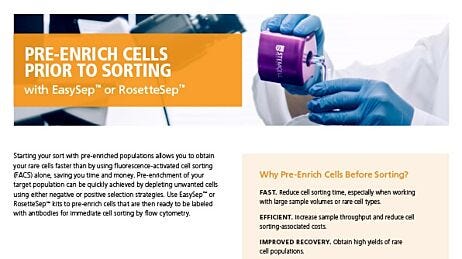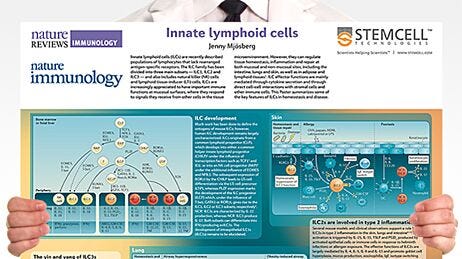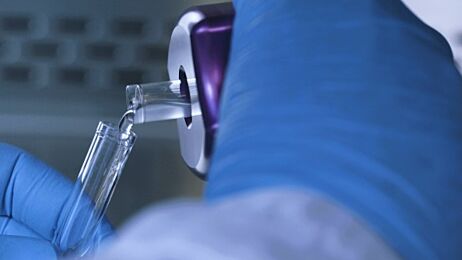Group 2 Innate Lymphoid Cells (ILC2)
Immunology Feature
Starting in 2010, research groups began to identify cells that have characteristics of lymphoid cells but lack lineage markers (Lin-) and re-arranged antigen specific cell surface receptors.1,2 As these cells were identified they were referred to by different names such as natural helper cells,3,4 nuocytes,5 innate lymphoid cells6 and innate helper 2 cells.7 In 2013 a uniform nomenclature was proposed to classify these cells as group 2 innate lymphoid cells (ILC2s).8
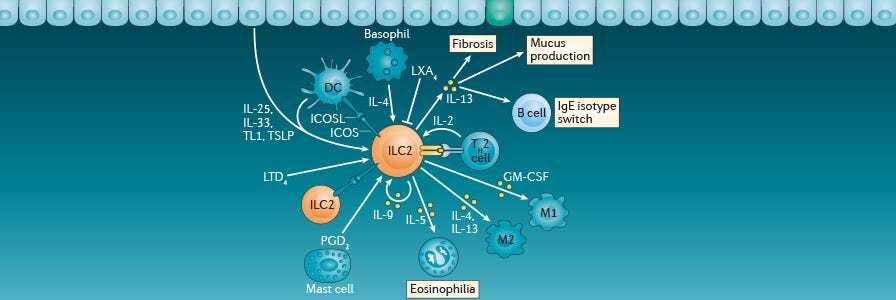
ILC2s are part of the larger ILC family that is divided into three major groups: group 1 ILCs (ILC1s), group 2 ILCs (ILC2s) and group 3 ILCs (ILC3s).8 These groups differ in their surface markers, cytokine secretion and functional specialization.
This free Nature Protocols wallchart summarizes the development, classification, plasticity and functional diversity of all groups of ILCs.
Here, we review some of the recent findings on the function of ILC2s, and advancements in methods and experimental techniques for the analysis of ILC2s.
Function: Role of ILC2s in Allergic Inflammation
ILC2s serve crucial functions in many different tissues, but are especially enriched in barrier tissues, such as the lung, gut and skin. Here, we will focus on lung ILC2s and their role in orchestrating the immune responses in allergic inflammation. ILC2s are activated by epithelial cell-derived interleukin-25 (IL-25), IL-33 and thymic stromal lymphopoietin (TSLP), which are released during exposure to allergens. Activated ILC2s proliferate and secrete large amounts of type 2 cytokines, including IL-5 and IL-13.4,9 Furthermore, lung ILC2s are crucial for the induction of eosinophilia and mucus hyperproduction in response to protease allergens, indicating their importance in allergic inflammation.4 ILC2-derived cytokines in turn activate other cell types and initiate T cell- and B cell-dependent adaptive immune responses.
ILC2s are critical for the initiation of adaptive T helper 2 cell-mediated allergic lung inflammation10
Immunity
T helper 2 (Th2) cells are important to drive type 2 adaptive immune response in allergic inflammation. In this study, Halim et al. show that ILC2s are required for the differentiation of Th2 cells in response to allergens. Activated ILC2s in the lungs produce large amounts of IL-13, causing the migration of dendritic cells to the draining lymph nodes where they induce the differentiation of Th2 cells.
Cell separation: EasySep™ Mouse CD4+ T Cell Isolation Kit
ILC2s promote an early antibody response to a respiratory antigen in mice11
Journal of Immunology
Humoral immunity is a key component of the adaptive immune response. In this article, Drake et al. show that lung ILC2s enhance B cell proliferation and antibody production. ILC2-derived IL-5 is specifically crucial in promoting the production of IgM antibodies.
Cell separation: EasySep™ Mouse PE Positive Selection Kit and EasySep™ Mouse B Cell Isolation Kit
Allergen-experienced ILC2s acquire memory-like properties and enhance allergic lung inflammation12
Immunity
Although they’re a part of the innate immune system, recent observations suggest that ILC2s possess memory-like function. Some ILC2s persist long after the resolution of lung inflammation, and respond more vigorously to a subsequent exposure to unrelated allergens. These experienced ILC2s induce Th2 differentiation more potently than inexperienced ILC2s, and have a similar gene expression profile to memory T cells.
Cell separation: EasySep™ Mouse ILC2 Enrichment Kit
The discovery of ILC2s has led to answers to many outstanding questions in allergic inflammation. Findings such as those summarized above place ILC2 at the center of type 2 immunity, as initiator and orchestrator.
Analysis: Identification, Isolation and Culture of ILC2s
The complexity of ILC2s make them difficult to identify. In addition, ILC2s are rare, composing less than 1% of the total leukocyte population2, which creates a challenge for scientists to isolate them for experiments.
Identification of ILC2s
Like other ILCs, ILC2s are first defined by the absence of hematopoietic lineage markers (Lin-), including CD3ε, CD19, CD11b, CD11c, Ly-6G, NK1.1 and Ter119. ILC2s express several surface markers that can be used to positively label their surface, including CD45, ICOS and ST2.
Isolation of ILCs
Rather than isolating ILCs solely via fluorescence-activated cell sorting, many researchers are beginning to pre-enrich for ILCs prior to cell sorting. This technique improves the yield and purity of the final sorted population of ILC2s, and significantly reduces the time required to isolate ILCs.
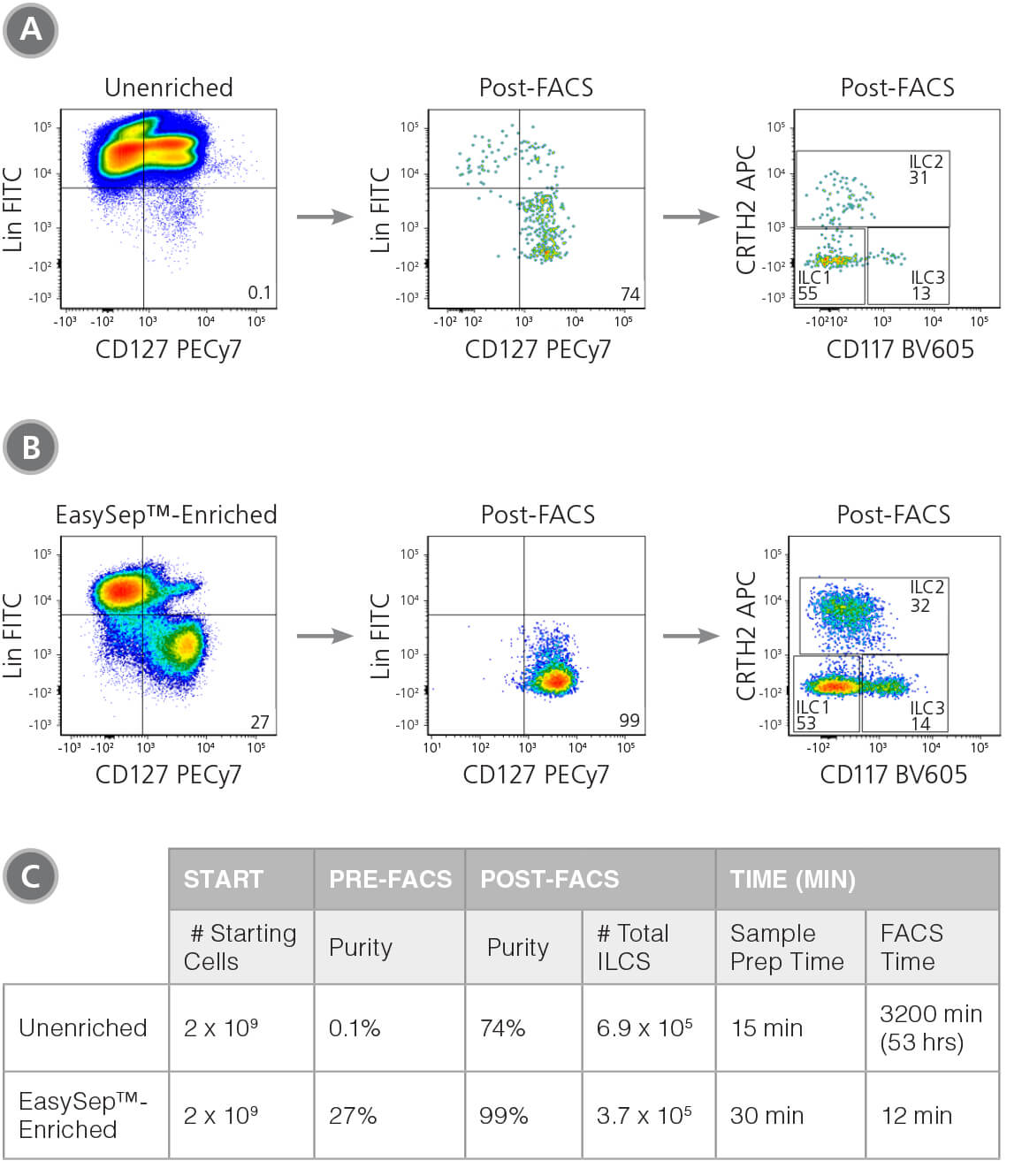
Figure 1. Pre-enrichment with EasySep™ Significantly Reduces the Time Required to Obtain Pure ILCs
Starting with a fresh leukapheresis sample, ILCs were isolated in parallel from an unenriched or an EasySep™-enriched sample. (A) In an unenriched sample, ILC frequency was assessed by flow cytometry at the start and after one round of FACS. (B) In an EasySep™-enriched sample, ILC frequency was assessed immediately after EasySep™-enrichment, and again after one round of FACS. (C) Corresponding purities and FACS times at each stage are reported.
View the complete case study to learn how to use pre-enrichment for rapid isolation of functional ILCs .
Culture of ILC2s
IL-33, IL-25, and TSLP induce a distinct phenotypic and activation profile in human type 2 innate lymphoid cells12
Blood Advances, 2017
The ability to culture ILC2s in defined conditions can open avenues for a more controlled and in-depth study on the mechanisms that regulate ILC2s. In this article, Camelo et al. describe a method to culture human ILC2s in defined conditions without the use of feeders to analyze the effects of various cytokines. The study shows that TSLP promotes the survival of ILC2, whereas IL-33 is crucial for their activation, especially in combination with IL-2 and TSLP.
Cell separation: EasySep™ Human NK Cell Isolation Kit, EasySep™ Human CD56 Positive Selection Kit II and SepMate™
Cell culture medium: StemSpan™ SFEM II
Concluding Remarks
ILC2s are crucial in initiating and orchestrating type 2 immunity, and the ability to isolate these cells for various in vitro and in vivo assays will help scientists to uncover their mechanisms. The use of ILC enrichment kits prior to cell sorting enables researchers to quickly isolate more ILC2s with high purity.
Explore These Resources
References
- Artis D & Spits H. (2015) The biology of innate lymphoid cells. Nature 517(7534): 293–301.
- Spits H & Cupedo T. (2012) Innate lymphoid cells: emerging insights in development, lineage relationships, and function. Annu Rev Immunol 30(1): 647–75.
- Moro K et al. (2010) Innate production of T(H)2 cytokines by adipose tissue-associated c-Kit(+)Sca-1(+) lymphoid cells. Nature 463(7280): 540–4.
- Halim TYF et al. (2012) Lung natural helper cells are a critical source of Th2 cell-type cytokines in protease allergen-induced airway inflammation. Immunity 36(3): 451–63.
- Neill DR et al. (2010) Nuocytes represent a new innate effector leukocyte that mediates type-2 immunity. Nature 464(7293): 1367–70.
- Buonocore S et al. (2010) Innate lymphoid cells drive interleukin-23-dependent innate intestinal pathology. Nature 464(7293): 1371–5.
- Price AE et al. (2010) Systemically dispersed innate IL-13-expressing cells in type 2 immunity. Proc Natl Acad Sci U S A 107(25): 11489–94.
- Spits H et al. (2013) Innate lymphoid cells--a proposal for uniform nomenclature. Nat Rev Immunol 13(2): 145–9.
- Licona-Limón P et al. (2013) Th2, allergy and group 2 innate lymphoid cells. Nat Immunol 14: 536-42.
- Halim TY et al. (2014) Group 2 innate lymphoid cells are critical for the initiation of adaptive T helper 2 cell-mediated allergic lung inflammation. Immunity 40(3): 425-35.
- Drake LY et al. (2016) Group 2 innate lymphoid cells promote an early antibody response to a respiratory antigen in mice. J Immunol 197(4): 1335-42.
- Martinez-Gonzalez I et al. (2016) Allergen-experienced group 2 innate lymphoid cells acquire memory-like properties and enhance allergic lung inflammation. Immunity 45(1): 198-208.
- Camelo A et al. (2017) IL-33, IL-25, and TSLP induce a distinct phenotypic and activation profile in human type 2 innate lymphoid cells. Blood Adv 1: 577-89.
